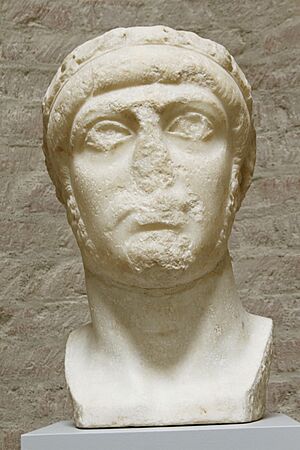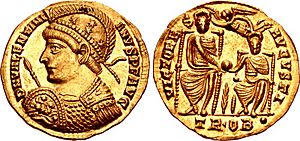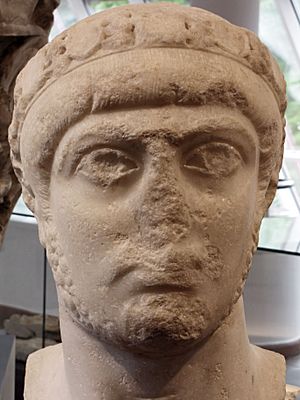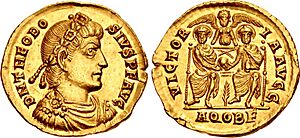Gratian facts for kids
Quick facts for kids Gratian |
|||||
|---|---|---|---|---|---|

Bust of Gratian found in Trier.
|
|||||
| Roman emperor (in the West) | |||||
| Augustus | 24 August 367 – 25 August 383 (senior from 17 November 375) | ||||
| Predecessor | Valentinian I | ||||
| Successor | Magnus Maximus | ||||
| Co-rulers |
|
||||
| Born | 18 April 359 Sirmium, Pannonia Secunda (present-day Sremska Mitrovica, Serbia) |
||||
| Died | 25 August 383 (aged 24) Lugdunum, Gallia Lugdunensis (present-day Lyon, France) |
||||
| Burial | Imperial mausoleum at Mediolanum (now Sant'Aquilino, Basilica of San Lorenzo, Milan) | ||||
| Spouse |
|
||||
|
|||||
| Dynasty | Valentinianic | ||||
| Father | Valentinian I | ||||
| Mother | Marina Severa | ||||
| Religion | Nicene Christianity | ||||
Gratian (Latin: Gratianus; born April 18, 359 – died August 25, 383) was an emperor of the Western Roman Empire. He ruled from 367 to 383. He was the oldest son of Valentinian I.
Gratian became an Augustus (a high imperial title) when he was a child. He took over the Western Roman Empire after his father died in 375. He shared power with his younger half-brother, Valentinian II, who was also named emperor. Gratian's uncle, Valens, ruled the Eastern Roman Empire. Later, Theodosius I took over from Valens.
Gratian led a military campaign across the Rhine and made the Lentienses tribe surrender. In the same year, Emperor Valens was killed fighting the Goths at the Battle of Adrianople. This led Gratian to choose Theodosius to replace Valens in 379. Gratian preferred Nicene Christianity over the traditional Roman religion. He issued the Edict of Thessalonica, which made Nicene Christianity the official religion. He also refused the title of pontifex maximus (a chief priest title) and removed the Altar of Victory from the Roman Senate's meeting place. The city of Cularo in Roman Gaul was renamed Gratianopolis after him, which is now Grenoble, France. In 383, a general named Magnus Maximus rebelled. Gratian marched his army towards Lutetia (modern Paris), but his soldiers left him. He fled to Lugdunum (modern Lyon) and was later killed.
Contents
Early Life and Rise to Power
Gratian was born on April 18, 359, in Sirmium, which is now Sremska Mitrovica in Serbia. This information comes from old records like the Chronicle of Jerome. His parents were Valentinian I and Marina Severa. Gratian was their only son. At the time he was born, his father was living away from home. Gratian was named after his grandfather, Gratianus Funarius, who was a military leader.
After Emperor Jovian died in 364, Gratian's father, Valentinian, was declared Augustus (emperor). Soon after, Valentinian made his brother, Valens (Gratian's uncle), Augustus of the Eastern Empire. In 366, Gratian was made a consul. His father also gave him the title nobilissimus puer, which meant he was a very noble boy and likely to become emperor. Gratian was seven years old when he received this title. His teacher was a famous speaker named Ausonius, who wrote about their relationship.
Gratian's Reign
In the summer of 367, Valentinian became sick. This made people wonder who would rule next. After he recovered, Valentinian presented his eight-year-old son, Gratian, to his troops on August 24. He made Gratian a co-augustus, skipping the usual step of being a caesar first.
Co-Emperor with his Father
Valentinian was worried about Gratian's young age and lack of experience. He said his son would help commanders with future military campaigns. Two important generals, Merobaudes and Sebastianus, were sent by Valentinian to fight against the Quadi tribe.
In 365, the Alamanni tribe attacked Roman lands after they felt insulted by a Roman official. Even though they were strong, a Roman general named Jovinus defeated them in Gaul. In 368, Gratian and his father attacked the Alamanni, causing a lot of damage. Gratian was given special victory titles like Germanicus Maximus and Alamannicus Maximus for these wins.
Valentinian built forts along the Roman border to protect it. He also tried to get help from the Burgundians tribe against the Alamanni, but it didn't work out. Later, a general named Theodosius the Elder and his son Theodosius (who would become Emperor Theodosius I) attacked the Alamanni. They captured many prisoners and moved them to Italy.
In 374, Gratian, who was 15, married Constantius II's daughter, Constantia. She was 13 years old. They were married in Trier.
The Romans needed to make peace with some tribes because of new threats from the Quadi and Sarmatians. These tribes were angry because the Romans built forts near their lands. The situation got worse when the Quadi king was killed during talks with the Romans in 374. The Quadi then attacked Roman provinces. The Sarmatians also joined in, causing heavy losses to Roman legions. However, they later asked for peace when they met Theodosius's forces. Valentinian launched another attack against the Quadi in 375. He died suddenly in November of that year.
Gratian Becomes Senior Emperor
When his father died on November 17, 375, Gratian became the main ruler of the Western Roman Empire. A few days later, Gratian's half-brother, Valentinian, was also declared augustus by troops. Gratian had to accept this, but he oversaw his younger brother's education. Even though Valentinian was given power over some areas, Gratian truly ruled the Western Roman Empire himself. His old teacher, Ausonius, became an important advisor.
Gratian's uncle, Valens, who ruled the East, asked Gratian for help against the Goths. Gratian sent some troops, but they never reached Valens. In July 378, Valens attacked the Gothic army near Adrianople (modern Edirne). He was misinformed about the number of enemy troops. Thousands of Romans died in the Battle of Adrianople, including Valens himself.
After Valens's death, Gratian became the senior augustus. He realized that one emperor could not fight all the enemies alone. So, on January 19, 379, Gratian appointed Theodosius I as augustus to rule the East. On August 3 of that year, Gratian issued a law against beliefs that were different from official Christian teachings.
On February 27, 380, Gratian, Valentinian II, and Theodosius issued the Edict of Thessalonica. This law made Nicene Christianity the only legal form of Christianity. It banned all other religions. This ended a time when many different religions were tolerated. Some historians say Gratian refused the robe of the pontifex maximus, a title for the chief priest of Roman religion. Emperors after Gratian used a different title, "honorable pontiff." The title pontifex maximus was later adopted by the bishops of Rome.
In September 380, Gratian and Theodosius met. They returned some Roman territories to Gratian's control and others to Valentinian II. In the same year, Gratian won another victory, possibly against the Alamanni.
By 380, the Greuthungi Goths moved into Pannonia but were defeated by Gratian. Because Gratian had left the region, the Vandals and Alemanni tribes threatened to cross the Rhine. The Roman border along the Danube was collapsing due to attacks from the Huns and Goths. So, Gratian moved his main city from Trier to Mediolanum (modern Milan) in 381. He became close with the city's bishop, Ambrose, and the Roman Senate.
In 382, Gratian issued new laws. He ordered the removal of the statue of the winged goddess Victory from the Senate floor. He also took away special rights from the Vestal Virgins (priestesses) and seized money meant for pagan sacrifices. He declared that all pagan temples and shrines would be taken over by the government. This caused protests from the Roman Senate, but Christian senators supported Gratian.
On January 16, 383, Theodosius made his son Arcadius a co-emperor. Gratian did not seem to approve of this. In the same year, Gratian's wife Constantia died, and he married Laeta. Neither marriage produced children.
In the summer of 383, Gratian was fighting the Alamanni again. Gratian upset his army by showing too much favor to some Alan soldiers who had left their own army and joined him. He made them his bodyguards and gave them important military roles. People also criticized him for surrounding himself with bad friends and neglecting his duties as emperor, preferring to have fun. Soon after, a Roman general named Magnus Maximus started a rebellion in Britain. Maximus, who had won a victory against the Picts in 382, declared himself augustus. He invaded Gaul with a large army and camped near Paris. Gratian's forces met him there, but many of Gratian's soldiers joined Maximus. This forced Gratian to run away.
Death and Burial
Gratian was chased by Andragathius, one of Maximus's generals. Gratian was killed at Lugdunum (modern Lyon) on August 25, 383. Maximus then set up his court in Trier. After Gratian's death, the 12-year-old Valentinian II became the only legal augustus in the West.
Maximus initially kept Gratian’s body for political reasons. It was not until 387, possibly after Magnus Maximus himself died, that Gratian's body was buried in Mediolanum (Milan) in the imperial tomb. Gratian was later declared a god, known as Latin: Divus Gratianus, lit. 'the Divine Gratian'.
See also
 In Spanish: Graciano el Joven para niños
In Spanish: Graciano el Joven para niños








